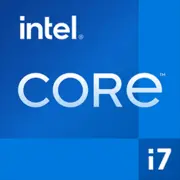Intel Core i7-12700H

인텔 코어 i7-12700H: 현대 노트북을 위한 성능과 효율성
2025년에도 인텔 코어 12세대 프로세서는 균형 잡힌 성능과 에너지 효율성으로 여전히 유효합니다. 이 라인업의 핵심 제품 중 하나인 인텔 코어 i7-12700H는 노트북 사용자들 사이에서 인기를 얻었습니다. 이 프로세서의 강점, 적합한 사용자 및 기반으로 할 장치를 선택할 때 주의해야 할 점을 살펴보겠습니다.
아키텍처와 기술: 하이브리드 코어 및 24MB 캐시
i7-12700H 프로세서는 Alder Lake 아키텍처 및 인텔 7(10nm Enhanced SuperFin) 공정으로 제작되었습니다. 이는 노트북 솔루션을 위한 인텔의 첫 하이브리드 디자인으로 두 가지 유형의 코어를 결합합니다:
- 6개의 성능 코어(P-cores): 하이퍼스레딩 지원(12 스레드)으로 리소스를 많이 사용하는 작업에 적합합니다.
- 8개의 효율 코어(E-cores): 하이퍼스레딩 없이 백그라운드 프로세스에 적합합니다.
총 코어 수는 14개, 스레드는 20개입니다. 클럭 속도는 다음과 같습니다:
- P-cores의 기본 클럭 속도: 2.3GHz, E-cores: 1.7GHz.
- P-cores의 최대 터보 클럭 속도: 4.7GHz.
캐시 메모리: 24MB L3 캐시로 멀티스레드 시나리오에서 응답성을 향상시킵니다(렌더링, 비디오 인코딩).
통합 그래픽:
- 인텔 아이리스 Xe (96 EU).
- 4K/60 FPS 지원, AV1 디코딩, HDMI 2.1.
- 엔트리 레벨의 디스크리트 GPU(예: NVIDIA MX450) 수준의 성능으로, 중간 설정에서 가벼운 게임(CS:GO, Dota 2)을 할 수 있습니다.
전력 소비 및 TDP: 성능과 자율성의 균형
프로세서의 정격 TDP는 45W이며, 터보 모드에서는 쿨링 시스템에 따라 95-115W에 이를 수 있습니다.
- 울트라북에서는 제조업체가 발열을 줄이기 위해 TDP를 35-45W로 제한하는 경우가 많습니다.
- 액티브 쿨링이 있는 게이밍 노트북에서는 프로세서가 전체 잠재력을 발휘합니다.
전력 절약 기술:
- 인텔 다이내믹 튜닝 2.0: 부하에 따라 자동으로 전력을 조절합니다.
- 스레드 디렉터: P-cores와 E-cores 간에 작업을 분산시켜 전력 소비를 최적화합니다.
성능: 사무실부터 AAA 게임까지
Geekbench 6(2025) 테스트 결과:
- 단일 코어: 2202 — Ryzen 9 6900HX(2050) 및 Apple M1 Pro(2100)보다 높습니다.
- 멀티코어: 11406 — Ryzen 9 7940HS(13000+)에 뒤지지만 이전 세대 인텔(i7-11800H — 9500)보다 우수합니다.
실제 시나리오:
- 사무작업 (Chrome, Excel): 8–12%의 부하로 즉각적인 응답성을 보여줍니다.
- 멀티미디어: Premiere Pro에서 4K 비디오 렌더링 속도가 i7-11800H보다 30% 빠릅니다.
- 게이밍: NVIDIA RTX 3060/4070와 조합 시 Cyberpunk 2077에서 60+ FPS를 안정적으로 유지합니다(High, DLSS).
터보 부스트 모드:
짧은 부하(애플리케이션 실행, 렌더링) 시 P-cores의 클럭 속도가 4.7GHz로 올라가지만, 장기 작업(5-10분 이상) 시 과열로 인해 쓰로틀링이 발생할 수 있습니다.
사용 시나리오: i7-12700H는 누구를 위한 것인가?
1. 전문가:
- 비디오 편집자, 3D 디자이너, 프로그래머. DDR5와 PCIe 4.0 지원으로 대용량 데이터 처리 시 유리합니다.
2. 게이머:
- 디스크리트 그래픽 카드로 Full HD/2K 게임 플레이.
3. 범용 사용자:
- 스트리밍, 그래픽 작업, 멀티태스킹.
자율성: 배터리가 얼마나 지속될까?
70–90Wh 배터리가 장착된 노트북에서:
- 사무실 모드 (밝기 150nit, Wi-Fi): 6–8시간.
- 비디오 시청: 4–5시간.
- 부하 (게임, 렌더링): 1.5–2시간.
전력 절약:
- E-cores로 전환 시 대기 모드에서 소비 전력이 2–5W로 줄어듭니다.
- 일부 ASUS 및 Lenovo 모델에서 Adaptix Battery Boost 기능이 자율성을 10–15% 연장합니다.
경쟁 제품과의 비교
1. AMD Ryzen 9 6900HX (Zen 3+):
- 멀티코어 성능이 뛰어나지만 단일 코어 테스트에서는 상대적으로 약합니다.
- TDP 45W, 통합 Radeon 680M이 Iris Xe보다 강력합니다.
2. Apple M1 Pro:
- 에너지 효율성이 높아(최대 12시간 지속)지만 Windows 소프트웨어와의 호환성이 제한됩니다.
3. 인텔 코어 i9-12900H:
- 10–15% 더 빠르지만 가격이 비쌉니다.
장단점
강점:
- 높은 단일 코어 성능.
- DDR5 및 Thunderbolt 4 지원.
- 작업과 게임 모두에 대한 범용성.
단점:
- 부하 시 발열이 효과적인 쿨링을 요구합니다.
- 예산형 노트북에서는 TDP 제한으로 인해 잠재력을 발휘하지 못할 수 있습니다.
노트북 선택 추천
1. 장치 유형:
- 게이밍 노트북 (MSI Katana GF76, $1400–$1600): 강력한 쿨링 시스템, RTX 4060/4070.
- 울트라북 (Dell XPS 15, $1700–$2000): 슬림한 디자인, 4K OLED 디스플레이.
- 워크스테이션 (Lenovo ThinkPad P1, $2200+): ECC 메모리 지원, ISV 인증.
2. 주의할 점:
- 쿨링 시스템: 최소 2개의 팬 및 열전도관.
- 배터리: 자율성을 위해 80 Wh 이상.
- 디스플레이: 게임용 — 144Hz, 작업용 — 100% sRGB.
최종 결론
인텔 코어 i7-12700H는 성능, 가격 및 자율성 간의 균형을 찾는 사람들에게 최적의 선택입니다. 이 프로세서는 다음과 같이 적합합니다:
- 높은 가격을 지불할 준비가 없는 게이머.
- "무거운" 애플리케이션으로 작업하는 전문가.
- 일상 작업에서의 속도를 중요시하는 범용 사용자.
2025년에는 이 프로세서를 탑재한 노트북이 $1200–$2000 가격대에서 찾아볼 수 있으며, 이는 인텔 14세대 및 Ryzen 8000의 새로운 모델에 대한 유리한 대안이 됩니다. 중요한 것은 양질의 쿨링 시스템과 충분한 배터리를 갖춘 장치를 선택하는 것입니다.
기초적인
CPU 사양
메모리 사양
GPU 사양
여러 가지 잡다한
벤치마크
다른 CPU와 비교
소셜 미디어에서 공유하기
또는 링크로 소개하기
<a href="https://cputronic.com/ko/cpu/intel-core-i7-12700h" target="_blank">Intel Core i7-12700H</a>



